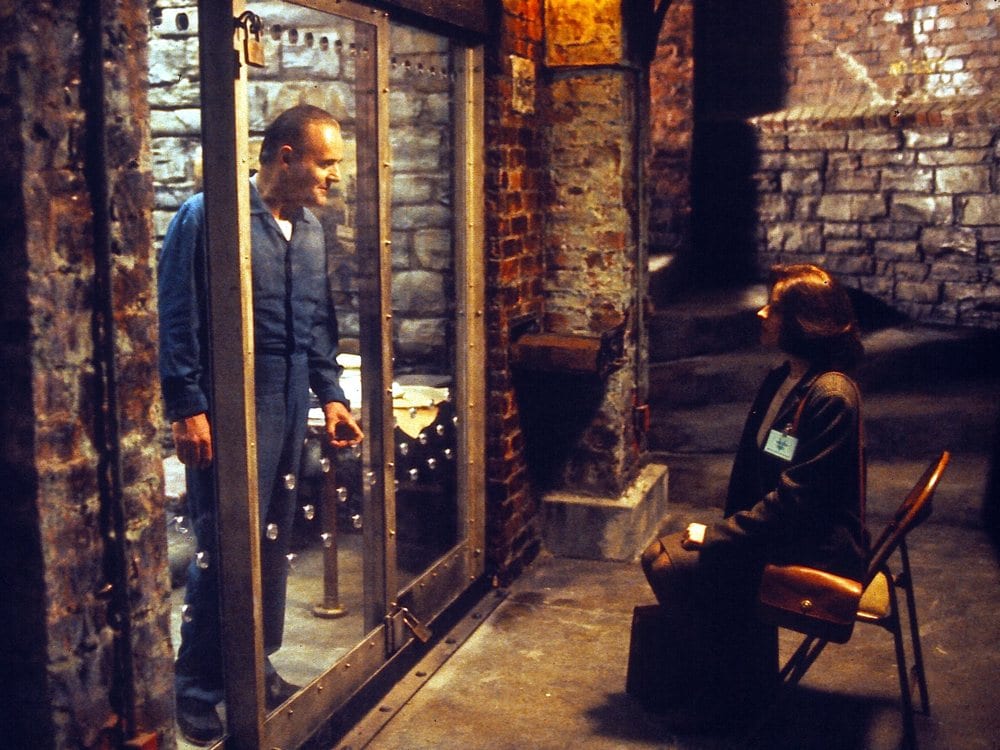Thirty years on from its initial release, Elisabetta Pulcini explores how The Silence of the Lambs both acknowledges and panders to society’s infatuation with serial killers.
Our obsession with depravity isn’t new. From Sophocles’ Oedipus Rex (429 BC) to Hitchcock’s Psycho (1960), the public have always been morbidly entertained by the darkest aspects of human nature. Many look to 1991’s The Silence of the Lambs, though, as one of the more successful and nuanced explorations of this obsession.
The subjects of all the films and TV shows that pander to society’s crime obsession are often psychopathic or sociopathic killers. Audiences can’t seem to get enough of the hidden horrors, or the idea that depravity can walk among us undetected. We’re drawn to villains who are neither obvious, nor driven by a vengeful motive. We are drawn to the fascinating stranger that will dismember us. Simply put, we are drawn to the purest form of evil.
This, of course, has received heavy criticism for its role in creating stigma around, and creating generalizations about, mentally ill people. Star of Netflix’s You, Penn Badgley, has himself criticized the viewers who root for his deeply problematic character. Perhaps this is because it’s happened in real life. Ted Bundy is the textbook example: at the mere mention of his name, many might remember his notorious fangirls, who were smitted by his charm, before his actual victims. A judge later marveled at Bundy’s good looks and intelligence, saying: “You’re a bright young man. You would have made a good lawyer, I would love to have you practice, but it went another way, partner. Take care of yourself.”
Rather than demonizing our obsession with darkness, The Silence of the Lambs director Jonathan Demme invites us to fall into the very same trap of the protagonist. The film follows Clarice Starling (Jodie Foster), an FBI agent, who seeks help to catch a serial killer from Hannibal Lecter (Anthony Hopkins), a former psychiatrist and convicted cannibalistic killer himself.
We meet Hannibal Lecter through Clarice’s eyes. Her initial curiosity is not unusual; much like the viewer, she is drawn in by his admirable intellect and fascinated by his complete lack of conscience. He stands out among the criminals he is locked up with, who are uncouth, violent, or sexually deviant. This is a common characteristic in the psychopaths we are drawn to—it is always the person who masks the horror behind a face of courtesy that seems the most fascinating. We’re always intrigued and morbidly fascinated by the serial killer, school shooter, rapist, etc, who is described as “just a normal guy” by those who knew him. Our leniency is problematic, in more ways than the obvious; the villains we romanticize are always white men from a middle-class background, from You to Abducted in Plain Sight. Everyone else who falls outside of this description is often deemed vile, in an uncomplicated or uninteresting way.
The appeal of The Silence of the Lambs rests not on Hannibal alone, but on his relationship with Clarice. Instead of making the detective a two-dimensional stand in for the audience, she becomes every bit as interesting as he is. Hannibal is immediately drawn to her, not just because she is a woman among a sea of men. The movie isn’t about the monster lurking in the shadows: more than any other film, Hannibal is humanized by his curiosity in Clarice.
This is clear from their first encounter. Director Jonathan Demme was praised for his use of POV shots: these consisted in characters staring down the lens when talking to each other, substituting the more common ‘over the shoulder’ shot. The intimacy and connection delivered through these shots served to make the audience uncomfortable. Much like Clarice, we’re forced to engage in their conversation to learn what we need to know about the plot. We don’t get to safely stare at the killer from behind the screen: we are pulled in, close to the glass.
Yet the film does something uncommon for one of its genre: the killer stares back. As much as Clarice is fascinated by Hannibal, Hannibal is fascinated with Clarice. This is because conversation, in order to be meaningful, must be reciprocal. During their scenes together, we learn about them both. Every gruesome detail disclosed by Hannibal is accompanied by an equally interesting revelation of Clarice’s life: his viciousness, irrevocably tied to her demons. In this way, the creators reveal the root of our obsession with such subjects: it goes beyond curiosity to an innate need humans have to explore the depths of depravity. It is only by understanding these facets of our being that we learn, and we grow.
Therefore, The Silence of the Lambs succeeds where most depictions of evil fail. In fact, the film doesn’t merely cash in on our obsession for the dark: rather, it forces us to recognize the origin of it and, without judgement nor morality, to re-examine it in light of our own shadows.
Words By Elisabetta Pulcini
Support The Indiependent
We’re trying to raise £200 a month to help cover our operational costs. This includes our ‘Writer of the Month’ awards, where we recognise the amazing work produced by our contributor team. If you’ve enjoyed reading our site, we’d really appreciate it if you could donate to The Indiependent. Whether you can give £1 or £10, you’d be making a huge difference to our small team.
